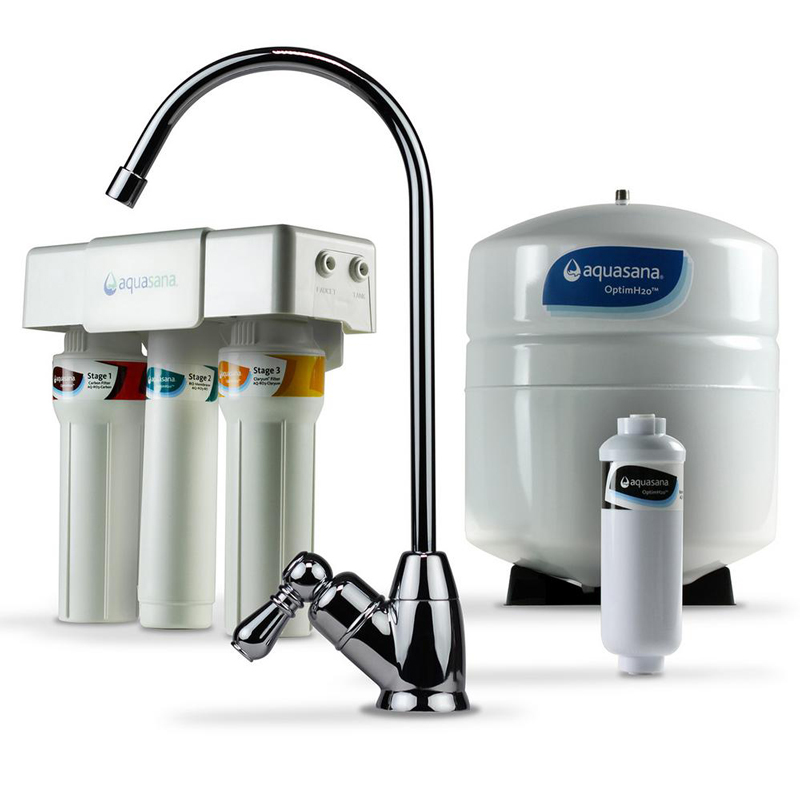Quick Links to Top Rated Products
Aquasana Water Filter Reviews
As one of the biggest, most popular water filter brands around, Aquasana produces an impressive range of filtering solutions, each backed by extensive customer reviews and a long, US-based manufacturing history. Here’s our take on Aquasana and their water filter innovations.

Aquasana Whole House Water Filter System
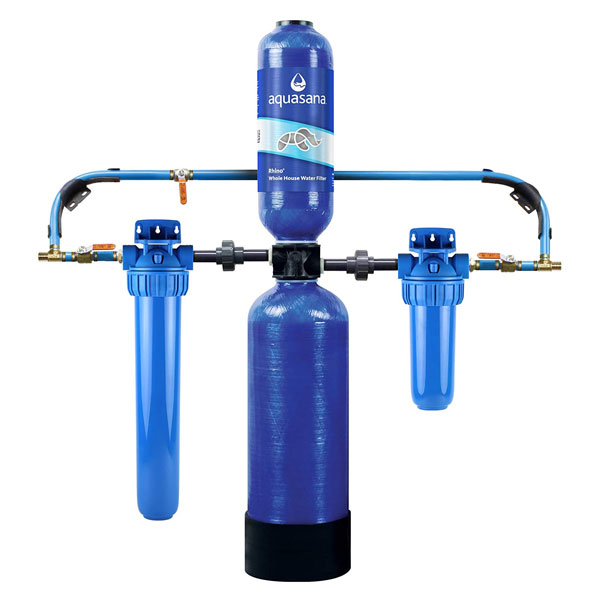
Format: Whole house
Technology: Carbon and KDF filtration
Contaminants: Sediment, chlorine, VOCs, lead and heavy metals, pesticides.
Value for money: 0.01 cents per gallon. 1,000,000 gallon capacity (approx 10 years)
Aquasana AQ-5300
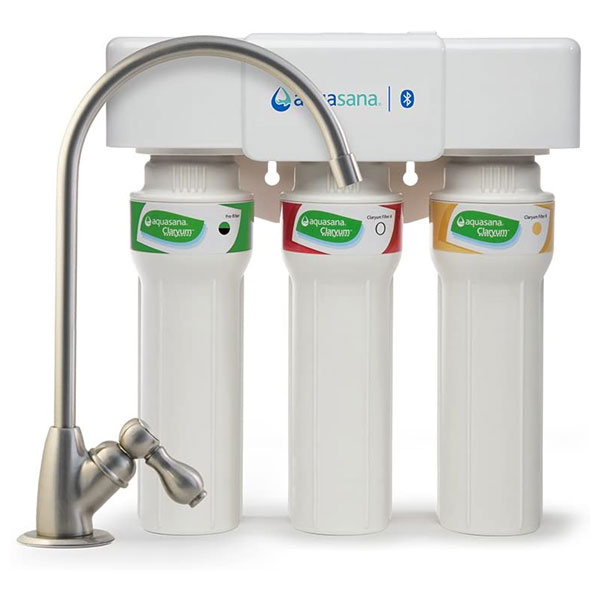
Format: Undersink
Technology: 3-stage Claryum filtration
Contaminants: Sediment, chlorine, VOCs, lead and heavy metals, pesticides, asbestos, pharmaceuticals, microorganisms.
Value for money: 0.08 cents per gallon. 800 gallon capacity (approx 6 months)
Aquasana OptimH2O
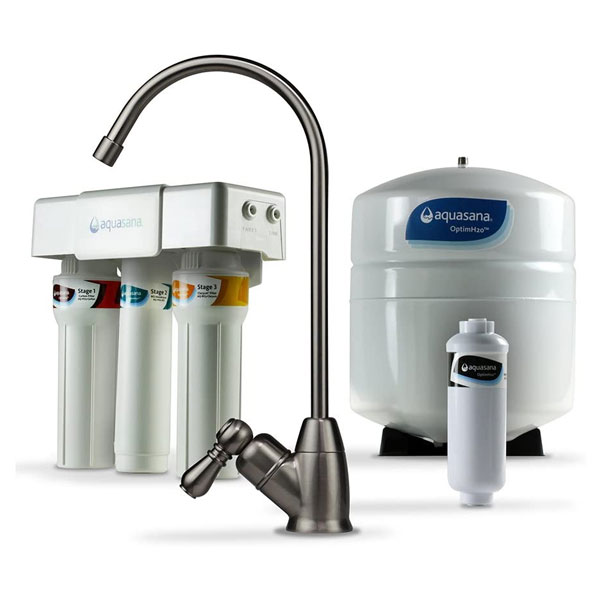
Format: Reverse osmosis (RO)
Technology: Reverse Osmosis, Carbon, Claryum filtration, Remineralization stage
Contaminants: Sediment, chlorine, VOCs, lead and heavy metals, pesticides, asbestos, pharmaceuticals, bacteria, viruses, fluoride, TDS.
Value for money: DIY installation, 1 year Ro Membrane Life, 6-month secondary filter lifespan
Aquasana AQ-4000W
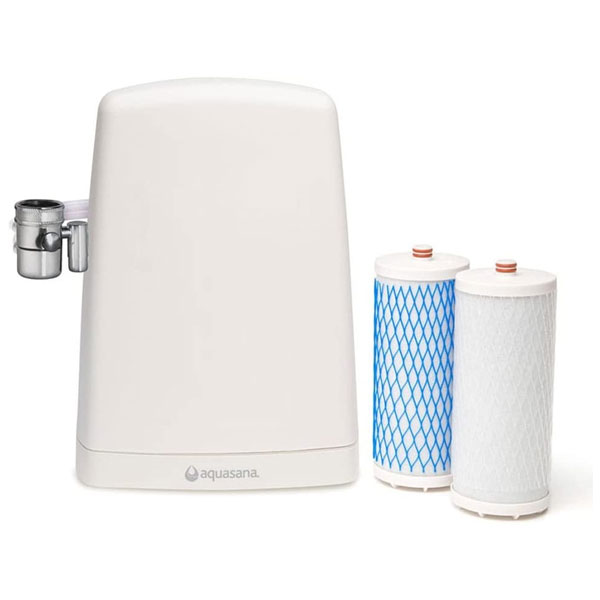
Format: Countertop
Technology: Claryum filtration
Contaminants: Chlorine, VOCs, lead and heavy metals, pesticides, pharmaceuticals, microorganisms
Value for money: $0.11 cents per gallon. 450 gallons (6-month lifespan). 11 times capacity of leading gravity filter
4.2 (479 ratings)
Aquasana AQ-4100

Format: Shower
Technology: Activated carbon, KDF filtration
Contaminants: >90% of chlorine, VOCs, pesticides, hydrogen sulfides
Value for money: $0.25 cents per gallon. 10,000 gallons (6-month lifespan)
4.4 (1446 ratings)
Who is Aquasana?
Operating out of Texas, Aquasana is a thoroughly tried-and-tested water filter producer, who have attracted well over 15,000 rave reviews from customers across their product range. Thanks to their popularity, Aquasana is able to invest in innovative filter technology and production methods, such as their commitment to more environmentally friendly methods. All of Aquasana’s products use reusable outer filter casings, and their filter cartridges are created from recyclable materials.
Aquasana’s NSF-certified Claryum Filtration technology is arguably their most innovative filter product. Their bespoke filter combines several filtering stages to produce highly pure water that retains desirable minerals such as magnesium and potassium. Each Claryum element includes:
- Activated Carbon, which is the most common home filtering element. Carbon filters reduce levels of carbon-based (organic) chemicals, such as chlorine, pharmaceuticals, and herbicides.
- Catalytic Carbon, which is optimized to target chlorine and treatment by-products.
- Ion-Exchange, which is designed to capture heavy metal ions such as lead, and replace them with harmless ions.
- Ultrafiltration/Mechanical filtration, which filters down to microscopic levels, catching chlorine-resistant microorganisms and materials like asbestos.
Aquasana: Key points
What to look for in a Reverse Osmosis Water Filter
Contaminants removed
| Contaminants | Certification to remove | Products |
|---|---|---|
| Harmful contaminants: Lead, Asbestos, Arsenic, Mercury, Cysts, VOCs etc.* | NSF 53, 58 | Aquasana OptimH2O, APEC RO-PH90, GE RO System, Whirlpool RO System, Brondell Circle RC100 |
| Chlorine and Chloramines/aesthetics issues | NSF 42 | Aquasana OptimH2O, Whirlpool RO System, Brondell Circle RC100 |
| PFAs | P473 | Aquasana OptimH2O |
| Emerging contaminants | NSF 401 | Aquasana OptimH2O |
*Check with product performance data sheets if you are concerned about a particular contaminant.
The top factor in choosing a RO water filtration system is the number of contaminants removed, or how much of a specific contaminant a filter can remove.
If you are worried about the quality of your water and are unsure of what is in it, then you should aim for the best product available that eliminates the most contaminants possible.
If you know exactly what contaminants are in your local water source, you can be more precise in your purchase. For example, if your local water source has trace amounts of lead in it, then you will want a water filter that can filter over 99% of lead, and other contaminants may not be as much of a worry for you.
RO water filters commonly remove the following contaminants: chlorine, iron, lead, asbestos, TDS (total dissolved solids), bacteria, cysts, and fluoride along with many others.
We recommend finding out what contaminants are in your water source by checking your local Consumer Confidence Reports (CCR), or getting your private well water tested. This is because different systems remove different contaminants so choosing your product should be based on your specific needs.
Here are our main contaminants of concern and reasons why:
There are also many other contaminants (too many to list), but if you get an RO water filter you can do your best to protect yourself and your loved ones from any adverse health effects.
Because of the potential for lead to get into your water through leaching from old pipes after it leaves the water treatment facility, we do not recommend any RO products that have not been certified or tested to reduce lead.
Certifications
To be sure filter systems are filtering out what they claim to, look for products that have NSF (National Sanitation Foundation) or WQA (Water Quality Association) certifications that are the gold standards in the USA for water filtration systems. NSF and WQA marks are meant to provide proof that a product was “impartially reviewed to established standards or guidelines,” states the NSF.org website.
NSF and WQA marks also confirm that product labels and their claims have been objectively verified by a trusted third party and demonstrate a company (or organization’s) commitment to quality, compliance, and safety. The mark, which is recognized in more than 180 countries around the world, has varying associated numbers that range from the automotive industry, retail products, lab equipment, nutritional products, sustainability, and of course, water, wastewater, and food safety.
For Reverse Osmosis filters, look for the following certifications:
NSF 42: Is certification to reduce mainly aesthetic or non-health related issues. These include chlorine, taste and odor, iron, manganese, and zinc.
NSF 53 and/or NSF 58 – Are certifications to reduce or eliminate contaminants that have known negative health effects. NSF 53 products have a carbon filter and can reduce contaminants to various degrees depending on the quality of the filter.
These contaminants include heavy metals (e.g., lead), Cryptosporidium, Giardia, pesticides, herbicides, benzene, MTBE, radon, trihalomethane, and PCBs. NSF 58 refers to reverse osmosis (RO) membrane filters, which can remove perchlorate, fluoride, nitrate, nitrite, radium, bacteria, cysts, and heavy metals. It is important to note that carbon filters and RO systems have many crossovers, but they do not filter out all of the same contaminants, as such they can be used in conjunction with one another in the same system.
NSF 401 – This certification is for new and emerging compounds, mainly as a result of pharmaceuticals, herbicides, pesticides, chemicals, flame retardants, and detergents being found in tap water that were previously not present.
NSF P473 – Certification to reduce PFAS, including PFOS (perfluorooctane sulfonate) and PFOA (perfluorooctanoate). To make this claim the product must be below to EPA healthy advisory limit of 70 parts per trillion.
Look for multiple certifications when searching for a water filter, and make sure they line up with the contaminants you either know or suspect are in your water source.
Best overall
NSF: 42, 53, 58, 401, P473
Price: $208.99
After getting through our top factors in choosing a reverse osmosis system, which are contaminant removal and certifications to prove it removes contaminants we wanted to introduce you to our top-rated product. It ticks a lot of our boxes, and to be our top choice it had to.
Pros:
Removes 99% of harmful contaminants including arsenic, lead, PFAS, and bacteria
Certified to NSF 42, 53, 58, 401 + P473
Compatible with well water systems
Large filtering capacity
RO + Carbon + Claryum + Remineralization
Value
2 year warranty
Cons:
Slower flow rate than some RO models
The Aquasana OptimoH2O has impeccable filtering, here are some of the main contaminants it can reduce or remove:
- Lead: 96.6%
- Chlorine: 97.66%
- Arsenic: 97.6%
- Cysts: >99.99%
- Emerging compounds: >94.2%
- PFAS: 96%
- Asbestos: 99%
Being tested and certified by the NSF to NSF/ANSI standards 42, 53, 58, 401 + P473, it is one of the most comprehensively certified RO systems available.
The Aquasana OptimoH20 utilizes a reverse osmosis membrane to reduce 14 impurities, and a patented Claryum filtration method to reduce 60 other contaminants. The filtering process is finished by remineralizing the filtered water with healthy amounts of calcium, magnesium, and potassium, which provides alkaline, pH balanced water. Here is a breakdown of the 3 stages + remineralization:
- Carbon filtration: Reduces organic chemicals, VOCs and MTBE
- RO membrane filtration: Filters out dissolved solids smaller than 1 micron including heavy metals.
- Claryum filtration: Targets chlorine and chloramine (aesthetic issues)
- Remineralization: Healthy amounts of minerals are absorbed back into the purified water to raise the pH level to a balanced level.
The Aquasana OptimoH20 is also our best RO system water filter for well water. With over 13 million American households relying on well water for drinking, it’s important to keep the water you drink from your well clean. Well water can have microorganisms such as bacteria, viruses and parasites in it, as well as nitrates, heavy metals, organic chemicals, radionuclides, and fluoride.
Essentially anything that can contaminate water can be in a well water source depending on where you live. The Aquasana filters 99% of bacteria, putting it in the top 1% of RO systems we assessed.
The filter life for the Aquasana Optimo is solid with the Carbon and Clayrum filters needing to be replaced every 6 months or 365 gallons, which will cost you ~$65. The RO membrane needs to be changed every 1-2 years according to Aquasana and will cost ~$60, and the remineralizer costs ~$30 and needs changing once a year. If you use less water in your home than you’ll only need to replace the RO membrane once every 2-3 years.
The total system and running cost (filter replacements) for 5 years will cost approximately ~$815, which is an amazing deal considering you are getting the best RO water filter on the market.
The system can give you up to 32 gallons per day, men require about a gallon of water a day, and women require just under 3/4 of a gallon a day according to the Mayo Clinic. So if you take this into account, it can provide enough drinking water for a large family.
Reverse osmosis systems require adequate water pressure to be able to function effectively. Before purchasing, you’re going to want to make sure you have at least 40 psi in your home.
If your home’s water pressure is below 40 psi, you’ll want to look for a RO model that has a booster pump. If your home uses well water, you’ll need to make sure the well pressure of the tank is set high enough to let the RO system work best.
Filter capacity depends on how much water you and yours are going to be using. Are you using it for drinking, washing, ice trays, or a combination of all three? Different systems filter different amounts so you’ll need to adapt accordingly.
If you are just looking for an RO system to fulfill your drinking water needs, then get a system that gives at least 9 gpd.
If you want to soak some dishes as well, then systems over 10 gpd will be better. And if you are a large family that will be using an abundance of filtered water, then a system that can filter over 30 gpd may be best.
Some models promote being able to filter 400 gpd, but this is unnecessary, no one will use that much water in a day, and if you do, you’re likely being very environmentally irresponsible.
An unfortunate downside to RO systems is that they can create a lot of wastewater.
Ideally you’ll want to look for systems with 1:1 to 3:1 ratios if wastewater is something you’re concerned with. Consumers can also find systems designed to reduce waste by repurposing it towards other hydro uses like gardening or dishwashing.
Systems with 1:1 ratios that are certified are difficult to find, and often they do not make their performance data readily available.
With reverse osmosis systems, the drain ratio average is 3:1. High ratios hover around 5:1, but to reduce many contaminants these systems usually need excess water to drain out contaminants.
We suggest you look for a model around the average 3:1 ratio, but don’t rule out higher ratio models, especially if you can repurpose excess water. We suggest using it for watering gardens.
Most RO systems require installation meaning a dedicated faucet and drain connection. If you’re a renter and can’t install a faucet or alter the already built-in plumbing, you’ll want to consider a countertop model, pitcher, or other filtration method.
If you’re a homeowner and you’re willing to do minor alterations, the RO system will be a great and long-lasting filtration option.
People with a ‘can do’ attitude and minor DIY skills will be adept at installing RO systems in a matter of minutes by following easy-to-follow instructions that come with every product. Some of which even offer instructional videos.
RO systems are designed to strip the water of not only its harmful contaminants, but also valuable minerals. The process makes the water slightly acidic, to restore pH levels some models offer remineralization.
The remineralization feature inserts healthy and valuable minerals back into the water at the end of the filtration process. If you’re looking for healthy minerals in your water, consider models that offer remineralization.
RO systems have a wide-range of pricing with low-end products at $100 and “premium models”at $1,000. Marketing teams will try and lead you to believe that more expensive units offer more filtration stages that can filter more water at a time. This is however not always correct.
We’ve found the best products or usually in that mid-range price category. Mid-range products will get the job done, and you won’t be spending needless $. We recommend spending around $200-300 for the purchase of a reverse osmosis system.
In addition, you’ll also want to take into consideration the annual cost of having a filter system, like individual filter replacements. You’ll likely save money on all the bottled water you won’t be buying anymore.
RO systems usually have multiple filters with different lifespans so it might be beneficial to protect your investment with a warranty.
Some products offer multiple-year warranties and we’d recommend buying products with at least a one-year warranty.
So, with all that said, here are some more of our best reverse osmosis systems to consider going forward. We tried to give you a range of specifics to help cover as much ground as possible.
Aquasana Whole House Water Filter System
The Aquasana Rhino whole house filters take the stress out of water purification, allowing you to access filtered water from every faucet or showerhead in your home. Aquasana’s whole-home system is designed to provide this little piece of luxury for an affordable price, by combining impressive—though not best-in-class—filter elements with a whopping million-gallon lifespan. It ranks as the best well water filtration system under $2000 due to its exceptional benefits listed above.

Aquasana Whole House Filter gives you healthy, clean, great-tasting water from every tap in your home by removing up to 97% of the chlorine in regular tap water. Get healthier skin and hair by reducing your body’s exposure to harsh chlorine and synthetic chemicals that can cause damage and excessive drying. Breathe easy knowing you have improved air quality by removing chlorine from your shower steam.
Filtering technology
This system combines carbon and KDF filtration, which are both designed to remove synthetic chemicals and metal traces from water. This makes the Aquasana whole house perfect for targeting the most common public water contaminants: chlorine, treatment chemicals, and tiny traces of metals that can leach into water from piping and bedrock.
If you’re looking for a whole house filter capable of treating water for microorganisms or dissolved solids, you’ll need a different type of filter technology.
Main contaminants removed/reduced
With its combination of screening and organic compound filters, this whole house-system will happily take care of contaminants including sediment, rust, heavy metals, chlorine, and other chemical solvents.
Value for money
Easily the most impressive aspect of this filter is the longevity of its replaceable parts. With a capacity to process one million gallons of water, this gives the Aquasana a potential 10-year life span before major replacements are needed. In terms of value for money, this puts the cost of clean water at just a cent per gallon, which may result in double the savings compared with other major brands, depending on raw water quality.
Anything else?
Part of the Aquasana’s mammoth lifespan is thanks to its unique dual tank design, which keeps water flowing for longer and helps prevent clogging.
A good middle ground between whole-house filters, which may require professional installation, and simple point-of-use kitchen filters is an undersink system. These products provide all the filtering power of a larger model whilst staying out of sight and out of mind. Aquasana’s AQ-5300 under sink model boasts an impressive array of filtering stages and can power through as much as half a gallon of water each minute.

Format: Undersink
Technology: 3-stage Claryum filtration
Contaminants: Sediment, chlorine, VOCs, lead and heavy metals, pesticides, asbestos, pharmaceuticals, microorganisms.
Value for money: 0.08 cents per gallon. 800 gallon capacity (approx 6 months)
4.2 (468 ratings)
Filtering technology
The AQ-5300 is one of several Aquasana filters in this review to use the unique Claryum filter design. Combining several common filtering elements into one replaceable cartridge, the Claryum filter is able to reduce harmful contaminants while retaining a beneficial mineral content for an improved taste.
Added to the Claryum filter are two further stages including a prefilter with a 20-micron screen, which is able to pick up tiny pieces of sediment.
Main contaminants removed/reduced
Claryum filters use a carbon element to reduce chlorine and other organic chemicals, ion-exchange filters to remove heavy metals like lead and mercury, and a sub-micron mechanical filter to pick up common waterborne bacteria and microorganisms such as cryptosporidium and giardia.
While living pathogens are very rarely found in public treated water, those sourcing their tap supply from private wells, or those in areas prone to flooding, can breathe a sigh of relief that the Aquasana is able to handle this kind of health threat.
Value for money
Aquasana recommends replacing their undersink filter cartridges every 800 gallons, which, with regular use, should mean a lifespan of around 6 months between replacements. In terms of cost per gallon, this puts the AQ-5300 at around 8 cents—a highly competitive price.
Anything else?
Like the majority of Aquasana products, the AQ-53000 is fully certified to NSF standards 42, 53 and 401.
- NSF/ANSI 42. This means that a filter is certified to improve the appearance, taste, and smell of drinking water.
- NSF/ANSI 53: This validates a filter’s claim to be able to reduce or remove certain health risks from drinking water.
- NSF/ANSI 401: This means that a filter is able to reduce newly emerging contaminants as defined by the NSF.
Reverse osmosis (RO) filters, which push water through membranes with tiny, microscopic pores, are amongst the most effective home filters available. Aquasana’s OptimH2O is the first RO filter to combine a reverse osmosis membrane with their Claryum filtration technology, resulting in a system able to handle an impressively wide range of contaminants. In fact, it’s guaranteed to reduce up to 99% of more than 80 different contaminants.

Format: Reverse osmosis (RO)
Technology: Reverse Osmosis, Carbon, Claryum filtration, Remineralization stage
Contaminants: Sediment, chlorine, VOCs, lead and heavy metals, pesticides, asbestos, pharmaceuticals, bacteria, viruses, fluoride, TDS.
Value for money: DIY installation, 1 year RO Membrane Life, 6-month secondary filter lifespan
4.3 (216 ratings)
Filtering technology
The addition of a Claryum filtration stage (see above for details) gives the OptimH2O five times the filtering power of a regular RO system. Thanks to its remineralization stage, this system is also able to reintroduce the calcium, magnesium, and potassium lost when water passes through the RO filter. The result is RO-filtered water that doesn’t have the weird taste and texture sometimes caused by stripping the water of its mineral salts.
Main contaminants removed/reduced
Thanks to its assortment of filtering stages, the OptimH20 can reduce and remove all of the usual contaminants, including sediment, chlorine, VOCs, heavy metals, and pharmaceuticals—and then goes further, significantly reducing the levels of bacteria, viruses, fluoride, and total dissolved solids (TDS) in a tap supply.
Value for money
One of the great cost-saving features of the OptimH20 is that it’s designed for DIY installation, which means significant savings of labor costs for anybody prepared for a little home-plumbing. Add to this a 1 year RO Membrane Life, and 6-month secondary filter lifespan, and you get a system that pretty much takes care of itself.
Anything else?
The Aquasana OptimH20 comes with its own faucet, which is available in several finishes to suit your countertop.
A reliable reverse osmosis filter can be hard to find. Here’s how Aquasana measured up against the competitors.
Aquasana AQ-4000W
Our top pick for the best countertop filter of 2021, the Aquasana AQ-4000W is a sleek looking filter that won’t mess with the aesthetics of your kitchen. With a screw-on faucet attachment that doesn’t impede on flow rate too badly (relative to other countertop filters), this is a convenient way to improve the quality of your drinking water for a low price.

Format: Countertop
Technology: Claryum filtration
Contaminants: Chlorine, VOCs, lead and heavy metals, pesticides, pharmaceuticals, microorganisms
Value for money: $0.11 cents per gallon. 450 gallons (6-month lifespan). 11 times capacity of leading gravity filter
4.2 (479 ratings)
Filtering technology
The AQ-4000W contains just one filtering stage: a Claryum filter cartridge. But as we’ve mentioned in other sections, Aquasana’s innovative filter combines several different filtering methods in one, so this model retains decent contaminant coverage.
Main contaminants removed/reduced
You can expect the AQ-4000W to significantly reduce all common public drinking water contaminants. This includes chlorine, VOCs, lead, pesticides, and pharmaceuticals. Unlike most countertop filters, this product will also remove microorganisms, thanks to the Claryum cartridge’s microfiltration stage.
Value for money
The best way to illustrate the cost savings possible when using a countertop filter is to compare them with traditional pitcher filters. Thanks to their longer lifespan (The AQ-4000W lasts for approximately 450 gallons or 6 months of regular use) countertop filters can handle up to 11 times the capacity of the leading gravity-based filters. Running the numbers on this Aquasana countertop model, value for money comes in it at $0.11 cents per gallon.
Anything else?
With a flow rate of 0.5 Gallons per minute, the AQ-4000W is at risk of becoming an inconvenience for those who demand immediate, fast-flowing tap water. Unfortunately, the flow rate can be an issue for all countertop filters, and this is definitely something to bear in mind when considering this filter format.
Aquasana AQ-4100
The bathroom might not be the first place you think of when considering a water filter, but removing chemical contaminants from your shower can make a big difference to your morning routine. Aquasana’s AQ-4100 shower filter is designed to capture the chlorine and other organic chemicals that are found in the majority of publicly-treated water, resulting in cleaner, softer, more moisturizing water to wash with.

Format: Shower
Technology: Activated carbon, KDF filtration
Contaminants: >90% of chlorine, VOCs, pesticides, hydrogen sulfides
Value for money: $0.25 cents per gallon. 10,000 gallons (6-month lifespan)
4.4 (1446 ratings)
Filtering technology/Main contaminants
With a simple attachment that clicks into your existing shower line (no tools necessary) the AQ-4100 adds two filtering stages to your shower head. The first is an activated carbon layer, which reduces chlorine, lead, and iron. This is followed up by a KDF copper and zinc oxidation process to further tackle harsh chemicals.
Value for money
Aquasana’s shower filter is designed to filter 10,000 gallons of average-quality tap water before requiring replacing, which equals around 6 months of daily showers, or 25 cents a day. Worth every cent, we’d say!
Anything else?
The AQ-4100 comes with the added benefit of multiple massage settings, ensuring that your shower head retains functionality.
Our verdict
With a large customer base and a wide range of filtering solutions, Aquasana’s fully NSF-certified home filters rank among the best water filter products available right now. We’re a fan of the brand’s unique claryum filter technology, and appreciate how they combine significant contaminant removal with long-lasting filter replacements.
If we had to find a negative, we’d say that the filtering power offered by many Aquasana products might be unnecessary for homes who get their water from reliable public sources, meaning that there may be more cost-effective options for some consumers. However, when it comes to ensuring a safe, good-tasting drink supply, Aquasana is definitely a brand to consider.
Disclaimer
CleanCoolWater aims to provide accurate, honest product recommendations, based on the best available information. Despite our best efforts, data and products are subject to change, and may have been updated since this page was posted. Always check with manufacturers for the most up-to-date product information.


